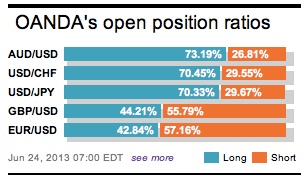The global rout continues. Currently, there is only one-way traffic, and it’s all about getting investors out of their current trades and into something ‘more’ liquid as they price out the “liquidity premium” provided by Central Banks. The global worries about the Fed tapering its bond-buying program, coupled with fears of a liquidity crunch in China, is sending all asset classes into another tailspin this Monday morning.
Continuing last week’s theme, equities, bonds and the Emerging Markets remain under pressure, even the safer short-end money markets is not immune as money continues to favor cash and the “dollar.” The capital market is finding it difficult to adjust to the idea that the Central Bank liquidity that investors have taken for granted over the past few years is about to dry up. The BIS has warned that the “longer the current accommodative conditions persist, the bigger the exit challenges become.” Hence, any adjustment will not be easy as various asset classes recalibrate their values. The Fed is not alone. This seems to be a coordinated exit strategy with the PBoC, who also want to “rein in the excesses.”

In its annual report, the BIS is urging central banks to weigh the risks associated with delaying their QE exit strategy. They argue that “there is a limit to what central banks can do, and there is a need for the involvement of other sectors and a shift to structural economic and financial reforms.” Up to now, ‘kicking the can’ down the road has effectively been about borrowing time.
In hindsight, people will be asking if the time was well spent? Policy makers have only so far been able to postpone the inevitable. The low interest rate environment coupled with various “unconventional policies” has only made it easier for the “private sector to postpone deleveraging and government to finance deficits and delay reforms.” It’s now time to pay the piper and this is what the market thinks its currently doing, pricing in its dues. The BIS also recognizes the importance of a smooth and well-timed exit –the global economy requires a “backdrop of solid recovery that puts the global economy on a path to balanced and sustainable growth.” The obvious danger is that the Fed’s timing may be off – Is the US experiencing only tenuous growth at best?
The view of a liquidity crunch in China is also impeding global asset prices. The country’s elevated interbank lending rates, despite easing from a two-year high print last week, has investors on the back foot. This morning, the PBoC has gone out of its way to try and calm investor’s already frail nerves. In a statement, Chinese policy makers are insisting that “banking system liquidity is at a reasonable level and commercial banks must closely monitor market liquidity while keeping stable and appropriate credit growth.” The perception is that the SME lack funds and that their monies “have been put in the wrong place.” The tightening bias seems to be sending a strong negative signal that credit growth will not continue and will affect China’s growth and growth forecasts.

The signs of any economic trouble with China are being felt with all its major trading partners. The market can expect capital outflows to be ramped up in Asia, South America and other Emerging economies this week, as “smart” money will only increase their withdrawal of funds from these regions. Their actions have the potential to spill over further into the commodity market. Investors long the yellow metal will be pushed into force liquidation of their gold positions as they seek more cash as a “funding mechanism.” Already, further depreciation of commodity and interest rate sensitive currencies is well in hand. The CAD is on course to seek out its 2011 lows as it plays catch up with its antipodean brethren (1.0520).
In contrast to the current global antics, German business manager’s confidence brightened further this month amid an improving business outlook. The German Ifo business confidence index managed to beat market forecasts, increasing for a second consecutive month to 105.9 vs. 105.7. With the manufacturing component looking strong, their business expectations for the next six-month also improved. However, it’s not sure if business managers were able to predict the current market carnage on offer that stared last week. The German economy is expected to grow up to +0.5% this year.

Euro traders now seem to be focusing on rising yields in the peripheral Euro-zone debt markets. Spanish 10-year debt managed to touch +5%, while Italy hovered near +4.7%. Pre-Ifo profit taking does not seem to want to support the 17-member single currency. The market will be expected to remain short-term bearish as long as EUR stays below 1.3225. Corporations and Central Bank bids are seen into 1.3080, with stop losses below, while speculator offers are dotted around 1.3140-60 along with some market stops. For the Yen, despite Japanese repatriation continuing, the dollar remains to be bought on dips-above ¥97.00, the next target is ¥99.00+.

This week Stateside, the market has to contend with US durable goods and confidence (Tue) and core PCE (Thu). In mainland Europe, it too has a confidence print (Thu), the EU summit (Thu/Fri), and inflation (Fri). Intermittingly, fundamental prints will be capped off with various Euro-zone supply of debt being issued.

Other Links:
EUR’s Kiss Of Death From Ben
Dean Popplewell, Director of Currency Analysis and Research @ OANDA MarketPulseFX
This article is for general information purposes only. It is not investment advice or a solution to buy or sell securities. Opinions are the authors; not necessarily that of OANDA Corporation or any of its affiliates, subsidiaries, officers or directors. Leveraged trading is high risk and not suitable for all. You could lose all of your deposited funds.


